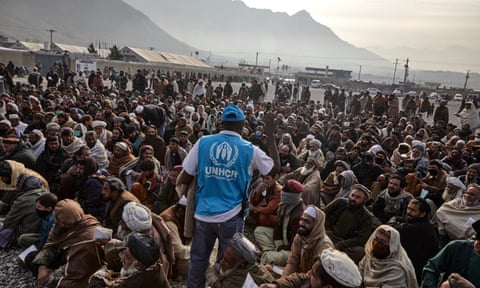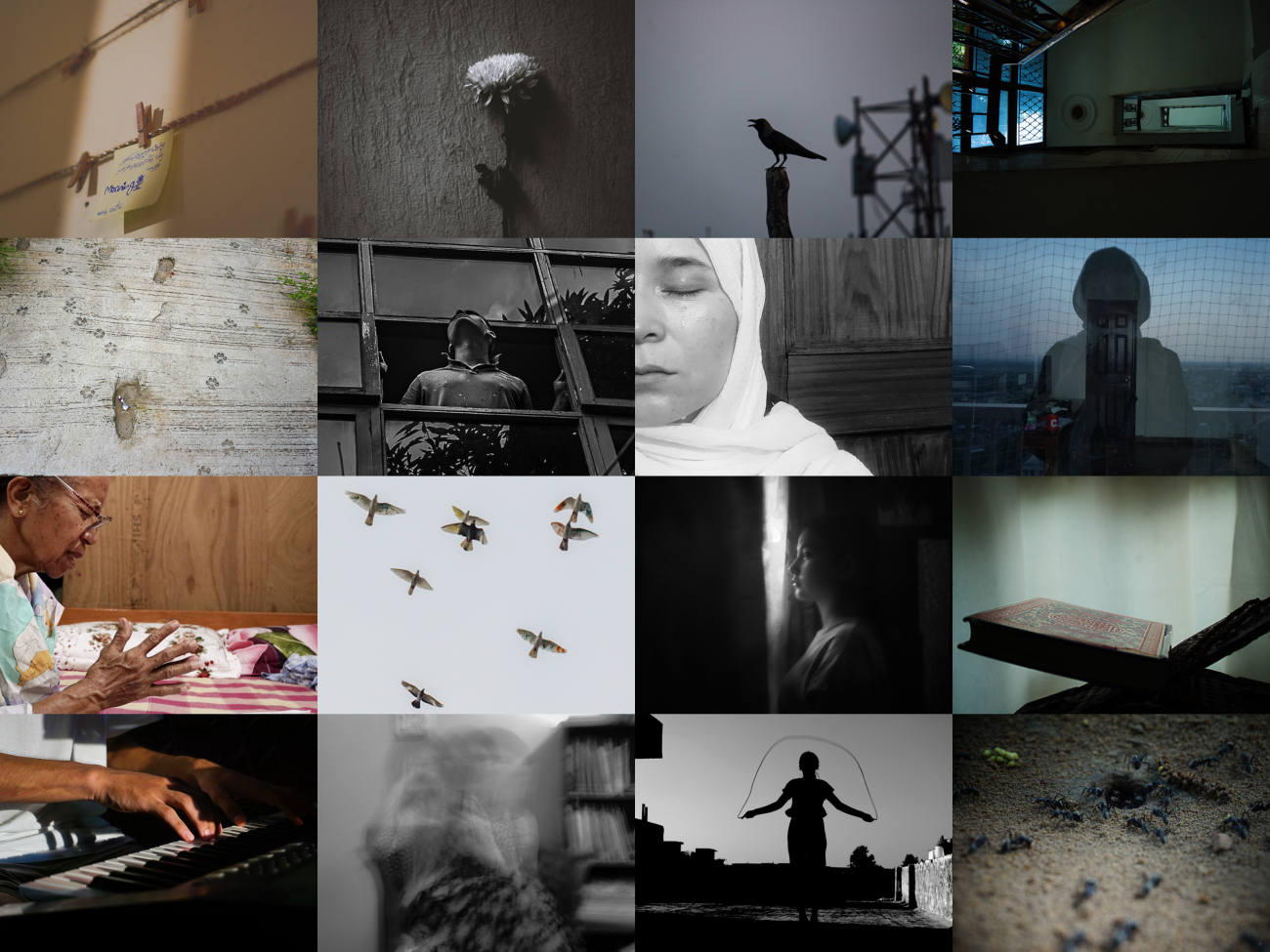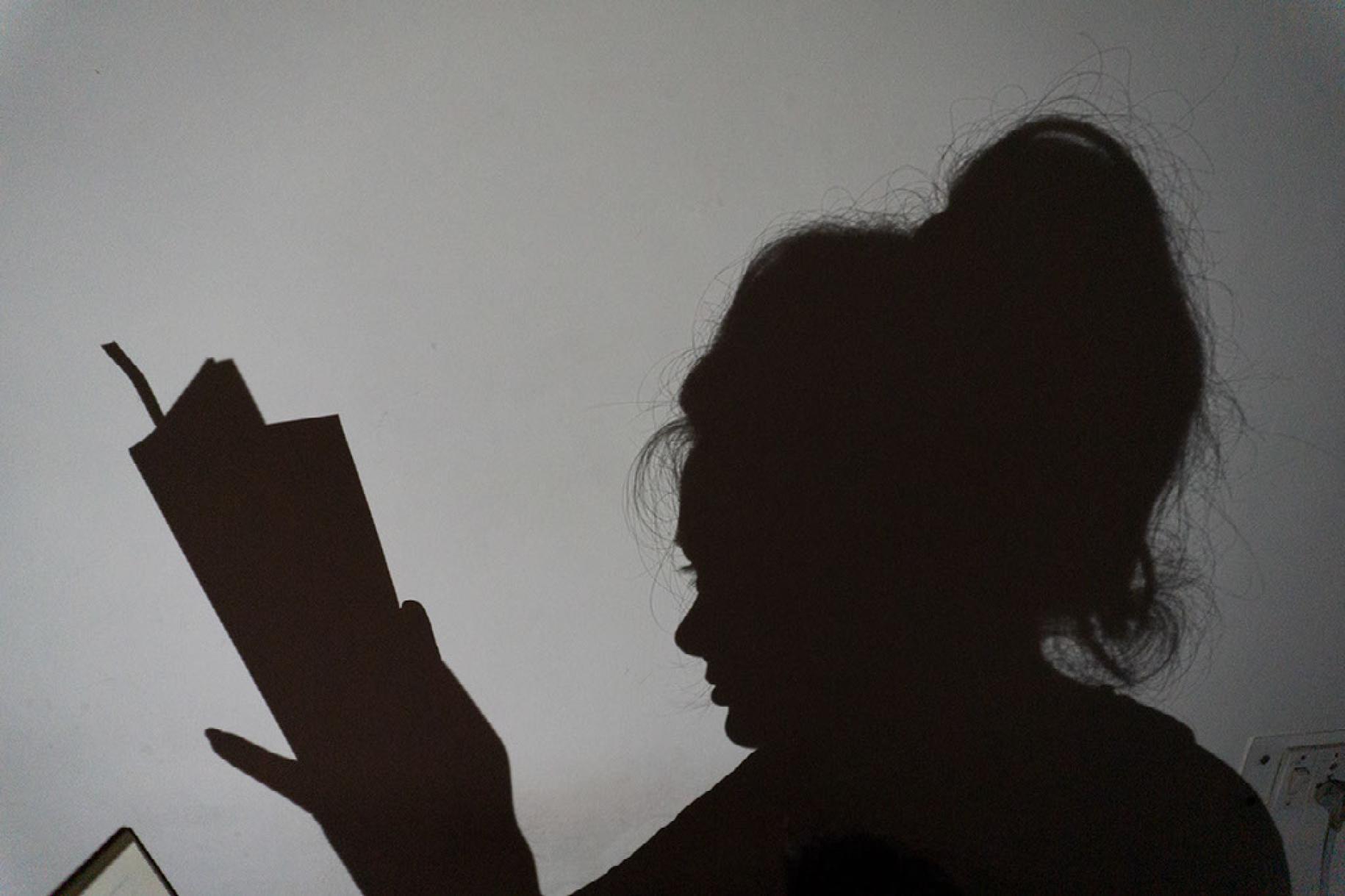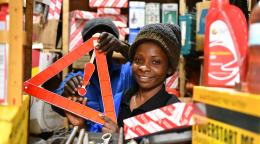

Famine: new battleground for displaced Afghans – a photo essay
Nearly 700,000 people have been forced from their homes in Afghanistan since the beginning of 2021, joining 2.9 million Afghans already internally displaced across the country at the end of 2020. The withdrawal of foreign aid after the Taliban took over Kabul has crippled the economy and led to a humanitarian crisis
“This is the first time I’ve been home in six years,” says Sayed Muhammad, 70.
But the sight that greeted his family on their return a few weeks ago was one of devastation. The entire back section of the house, which is located near a now-abandoned military base, had been reduced to rubble.
Much of the population of Marja in Afghanistan’s Helmand province has been displaced over the past decade, as it became the scene of intense fighting between the Taliban and coalition and former government forces. There is hardly a building in the town that does not bear the scars of the conflict.

Together with his wife and six children, Muhammad has moved into the one room of their house that still has a roof, fixing plastic sheets over holes in the walls. “We’ve put the door back, but it’s freezing at night,” he says.
Like tens of thousands of other internally displaced people (IDPs) now back home in former battleground districts in Helmand and elsewhere in Afghanistan, he is faced with a challenge bigger even than rebuilding: keeping his family fed.
“Sometimes we get vegetables, but mostly we are living on bread and tea,” he says. “All the children are hungry.”
Other people in this shattered town give similar accounts. Families cannot afford to buy enough food and those, like Muhammad, who returned in recent months will have to wait until the spring before they can start farming, and only then if the current drought eases. It is a microcosm of a nationwide crisis, with the UN World Food Programme warning that across the country only 2% of the population have enough food to eat, and more than half of children under five are at risk from acute malnutrition this year.

Women and children beg for bread outside a bakery in Kabul.

Left: A woman and her four children beg in the street in Kandahar. Right: The signs of drought are everywhere in the arid landscape of Helmand province.
Every week, Dr Mohammad Anwar – himself a recently returned IDP – sees increasing numbers of malnourished children in the small private clinic he runs in Marja. “Babies are being brought in half the weight they should be,” he says. He estimates that at least 2,000 children across the Marja area are now severely malnourished and at risk of dying.

Gul Khan*, 53, prepares to light the stove using shredded plastic as fuel in the family’s home in Kabul. They cannot afford wood to burn so buy sacks of shredded plastic to use instead.
Food shortages are a perennial problem in impoverished rural areas of Afghanistan. Even with outside donor support, the previous government struggled to tackle the issue, but without much of the foreign aid that paid most state salaries, the banking system paralysed by financial sanctions, and a prolonged drought that has withered crops and pastures, the situation is now far worse.

A shepherd drives his flock along the main irrigation canal in Kandahar. Drought in southern Afghanistan means the canal has been dry for the past five months.
Many IDPs who have returned to Marja and other districts are now deeply in debt, after borrowing money to buy food or repair their homes. Muhammad says he owes shopkeepers and other creditors at least 50,000 Afghanis (£350). “I need food. I need cash, but no one has given us any help so far.”
Mohammad Sadiqi, an assistant liaison officer for the United Nation’s refugee agency, the UNHCR, in Helmand, says the signs are pointing to “more malnutrition cases in all districts affected by heavy fighting”.
“If the situation carries on like this over the winter, most families in Helmand will become poorer than they have ever been, and many will die,” he says.

Sediqullah*, 58, with some of his children at the family’s temporary accommodation in Kandahar. Sediqullah has 12 in his family including his wife, elderly mother and nine children. The family are from Deh Rawood in Uruzgan Province and fled fighting in their area over the summer.
Working with local partner organisations, the UNHCR is responding to the needs of about 22,000 IDP families that have returned to Helmand. The focus has been on helping them to stay warm this winter as well as supporting them to repair their homes and reintegrate into communities.
A UN-wide $4.4bn (£3.2bn) plan for responding to humanitarian needs in Afghanistan in 2022 was launched on 11 January. If funded , it will scale up delivery of food and agricultural support, health services, emergency shelter and water and sanitation.

Mullah Ahmed* and his five-year-old son Assadullah* transport firewood back to their temporary home in Kabul. He was able to buy the fuel after receiving a cash payment from UNHCR to help his family meet their winter needs.

Left: The family of Abdul Sattar* at their accommodation in Kabul: his mother, Bibi Khatoon*, and his wife, Safa*, with two of their children, Ahmad Safa, 2, and a 40-day-old son. Right: Rehman Gul*, 40, with his two-year-old daughter Nazia*, near their home on the outskirts of Kabul. The family fled their home in Jalalabad 10 years ago because of fighting.
The key factor in rising child malnutrition is insufficient food for mothers, says Anwar. “They are not getting enough protein, so they can’t feed their children properly.” He adds that a lack of clean water – exacerbated by the drought – is also playing a role, leading to diarrhoea and further weight loss.

The malnutrition ward in Indira Gandhi Children’s hospital in Kabul. With Afghanistan facing a hunger crisis an estimated 22.8 million people are facing potentially life-threatening food insecurity this winter.
In their weakened state, malnourished children are more vulnerable to illnesses that can quickly lead to irreversible decline and death. Most children also lack the warm clothes that would provide a defence against subzero winter temperatures. “Some malnourished kids have been getting pneumonia,” Anwar says.
He does what he can in his small clinic, but much more assistance is needed, and the root causes of the widespread hunger remain.

Children collect plastic to sell from the banks of the Kabul River. More than 4 million children in Afghanistan are now out of school and the dire economic situation is pushing more families to send their children out to work.
The effects of drought are apparent everywhere. Irrigation canals have dried up and crusts of salt cover many fields. The use of solar-powered pumps to tap ground water in order to grow opium – has pushed the water table lower, drying up the soil and leaving salt deposits behind that make it even harder to grow legal crops.
The start of the year finally brought rain, but in such large quantities that it caused flash flooding in both Helmand and neighbouring Kandahar, washing away homes and fields. Much of the water was lost rather than being stored and so any mitigating effect on the drought situation is likely to be temporary.
“All of our youth are leaving,” says UNHCR’s Mohammad Sadiqi. “What else can they do?”
“If the water stops for good, we’ll have to go to Iran or Pakistan,” says Fazl Mohammad, another former IDP, who returned to Marja in November. “Or we will just dig graves for ourselves.”

Afghans queue to enter Pakistan at the border crossing in Spin Boldak. Between three and four thousand Afghans cross this border every day in the hope of moving to Pakistan and taking advantage of the better economic opportunities that exist there.
Many are already on the move – no longer fleeing war, but the combined effects of climate change and economic collapse. “All of our youth are leaving,” says Sadiqi. “What else can they do?”
* Names changed for protection reasons
- The Guardian picture essay
- Afghanistan
- Humanitarian response
- United Nations
- South and central Asia
Most viewed
Funding the Resident Coordinator system: All you need to know.
- UN in Action
- Global Level
- Regional Level
- Countries and Territories
Regional Teams
Rcp: africa, rcp: arab states, rcp: asia and the pacific, rcp: europe and central asia, rcp: latin america and the caribbean, featured content.
- Resources Library
- Executive Board Session Documents
- UNCT Key Documents Library
- Annual UNCT Results Reports
- UNSDG Chair Report on DCO
- System-Wide Contribution to the SDGs
- UNSDG Data Portal
- How We Work (Our Common Premises)
- Resident Coordinator Statistics

2030 Agenda
- 2030 Agenda and the SDGs
- RCs and the Decade of Action
- Engaging with Human Rights Machinery
- About the Goals
- Goals Knowledge Platform
- Youth SDG Dashboard
- SDG Action Campaign
- Joint SDG Fund
- UNCT Toolkit
Quick links
Read more about the UNSDG members
How We Work
Read more about how the UNSDG works
- The UN Reform
- UN Development Coordination Office
Home and belonging in India: A story in colorful photos

In 2014, the United Nations General Assembly declared 15 July as World Youth Skills Day , to celebrate the strategic importance of equipping young people with skills for employment, decent work and entrepreneurship. This year's theme is: Transforming youth skills for the future. To mark the day, we bring you a photo essay from our team in India about an innovative skills-building programme for youth.
What is home? What does it mean to belong? This photo series follows the story of eight young refugees in India who took part in 6-month mentorship programme on ‘Home and Belongingness’ led by UNHCR India.
From June to December of last year, these young visual storytellers explored these questions, trying to understand and capture their personal journeys of home, family and identity.
As they record and reflect on their own journey touching on what they have lost and what they have found, their hopes, identities, past and present, the stories that emerged are little pieces that lead to a bigger picture of home and belongingness: a mother braids her daughter’s hair, a bird soars in the sky, a face peers out of a window, prayers, the sound of music. And new green leaves that symbolize hope.

Written by Antra Mudgal. You can find the complete photo essay here .
UNCHR is part of the UN India Country Team, which comprises UN entities on the ground in India, including APCTT, FAO, IFAD, ILO, IMF, IOM, MGIEP, UNEP, ESCAP, UN-Habitat, UN Women, UNAIDS, UNDP, UNDSS, UNESCO, UNFPA, UNHCR, UNIC, UNICEF, UNIDO, UNODC, UNV, WFP, WHO, and the World Bank. The UN India team is led by Resident Coordinator Shombi Sharp.
Latest news and updates


IMAGES
VIDEO
COMMENTS
Nearly 700,000 people have been forced from their homes in Afghanistan since the beginning of 2021, joining 2.9 million Afghans already internally displaced across the country at the end of 2020 ...
His powerful photo essay, “We Are Here Because We Are Strong”, was commissioned by UNHCR, the UN Refugee Agency, and published in Humanity magazine. Duley is a longtime collaborator with UNHCR and his previous projects for the agency include documenting the arrival of Syrian refugees in Greece in 2015.
This photo series follows the story of eight young refugees in India who took part in 6-month mentorship programme on ‘Home and Belongingness’ led by UNHCR India. From June to December of last year, these young visual storytellers explored these questions, trying to understand and capture their personal journeys of home, family and identity.